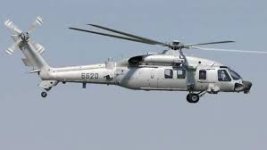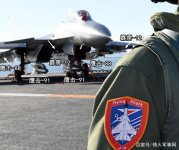Lol...
The indigenousness ends there
The widely applauded indigenousness of
Vikrant ends here, as nearly 70% of its ‘fight’ content and an almost equal proportion of its ‘move’ category is imported, adding substantially to its escalated building cost and taking the sheen off the Ministry of Defence (MoD)’s and IN’s indigeous claims. The former grouping includes 30 fighters and assorted helicopters, which Vikrant will eventually embark after completing flight trials, ahead of becoming fully operational and deployable as a battleworthy platform some 15 months from now, by end-2023.
Vikrant’s fighter component will, for now, comprise Russian MiG-29K/KUB fighters and Kamov Ka-31 ‘Helix’ early warning and control (AEW&C) helicopters and Lockheed Martin/Sikorsky MH-60R multi-role rotary craft. The 26 multi-role carrier-borne fighters (MRCBF), including eight twin-seat trainers, that the IN plans on acquiring, to supplement and eventually replace the operationally deficient MiG-29K/KUBs, too will be imported. The navy is presently evaluating France’s Rafale (M) and Boeing’s F/A-18E/F ‘Super Hornet’ fighters for acquisition, in a long-delayed move that has triggered harsh criticism from senior service veterans.
Former IN Chief of Staff Admiral Arun Prakash, for instance,
told Reuters on the eve of Vikrant’s September 2 commissioning that due to India’s ‘typically disjointed decision-making process’ the selection of carrier-based fighter got de-linked from the carrier project, and a decision on it was yet to be taken.
We knew the ship was likely to be commissioned this year, Admiral Prakash stated, and hence the selection process, as well as negotiations for the fighter, should have started well in time, perhaps three to four years earlier. He also said that while Vikrant had successfully undertaken sea trials, aircraft operations were yet to commence. “One hopes it will be a success story all the way,” the highly decorated aviator added.
Retired IN Captain Kamlesh Agnihotri from the National Maritime Foundation in New Delhi echoed Admiral Prakash and told Reuters that since the air wing was the main weapon of any carrier to render it operational and not having one was a ‘critical shortfall. It also prevented the carrier from being ‘exploited optimally’, he added.
Furthermore, Vikrant’s Aviation Facility Complex that includes arrestor gears, short-take-off but arrested recovery (STOBAR) systems for launch and recovery of fighters, and related diverse flight handling equipment – yet to be fitted onto the carrier – was from Russia’s Nevskoe Design Bureau. The carrier’s two aircraft lifts, used to house fighters three decks below the flight deck for storage, servicing and to be armed and bring them back up again, were from the UK, while the ammunition lifts were of US origin, and the aircraft hangar doors were Swedish.
Vikrant was also armed with 32 Israeli-origin Barak-8 Medium Range Surface-to-Air missiles (MR-SAMs) that are manufactured by Bharat Dynamics Limited in collaboration with Israel Aerospace Industries(IAI)-Elta. These, in turn, were supported by the Israeli EL/M-2248 MF-STAR multi-function active electronically scanned array radar, which too is reportedly yet to be fitted onto Vikrant.
Additionally, the carriers ‘move’ function was powered by four US General Electric LM-2500 gas turbines manufactured at the multinational’s Evendale plant in Ohio, but tested by the Industrial & Marine Gas Turbine Division of the public sector Hindustan Aeronautics Limited under a previous agreement. Collectively, these turbines generate 88MW or 120,000 hp that provide a maximum speed of 28 knots or 52km/hour to the carrier that has an operational endurance of 7.550 nm or 13,900 km.
Moreover, Project 71 also featured essential input from several foreign shipbuilders like France’s DCNS – now Naval Group – in the 1990s to audit CSL and Italy’s Fincantieri, to oversee Vikrant’s design and propulsion system integration in a $30-40 million contract agreed in mid-2004. Although the technical segment of this arrangement has been completed, Fincantieri’s association with Vikrant was committed to continuing through the duration of its sea trials to its commissioning, but it’s not known whether this relationship has concluded or continued. Spain’s state-owned Navantia shipbuilders were also believed to have been marginally involved in providing design expertise related to the carrier’s air groups integration.
Future expansions needed
“While it’s admirable for CSL and Indian industry to have contributed notably and successfully to Vikrant’s float aspect, their success in the move and fight category that is vital to all carriers is greatly restricted,” said a retired two-star IN officer. This needed expanding for any such future platform to qualify as an inclusive indigenous platform, he added, declining to be identified for commenting on such a sensitive matter.
Despite the government’s continuing hype over the
atmanirbharta initiative to indigenously source defence equipment, India’s defence industrial complex still remains one in the making. And, despite the involvement of private manufacturers over the past two decades, it is one with relatively competent engineering skills, but limited developmental expertise, and an inordinately high dependence on imported systems and components like engines, radar and electronic warfare units, amongst others.
The import content, for example, in India’s three showcase indigenous platforms – the Tejas light combat aircraft, Arjun main battle tank and Dhruv Advanced Light Helicopter – all of which were developed after interminable delays and massive cost overruns, averages 50-60%.
Consequently, all three platforms, in accordance with the MoD’s frequently revised Defence Procurement/Acquisition Procedures, stand disqualified as ‘indigenous’ due to their high import content. And, even the IN, for its part, credited with doggedly localising its warship building, compared to the indigenisation affected by the two other services, had emerged largely as a systems integrator, as demonstrated to a large degree by Vikrant.
Perhaps, it’s time for the MoD and the armed forces to look at indigenisation with an element of practicality and realism.










